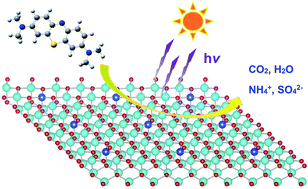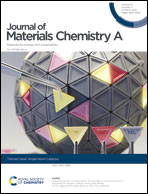Photocatalytic degradation of methylene blue (MB) with Cu1–ZnO single atom catalysts on graphene-coated flexible substrates†
Abstract
Defects can predominantly dictate the properties of oxide materials, in particular, photocatalytic and electrical properties. By implanting the defects of metallic element, Cu atom doped ZnO (Cu1–ZnO) supported by graphene-coated polyethylene-terephthalate (GPET) transparent substrate has been successfully synthesized via hydrothermal method. Our Cu–ZnO/GPET presents a high enhancement of photocatalytic activity by ultraviolet (UV) light illumination, with the degradation efficiency of methylene blue (MB) as high as 83.6%, which is superior to pure ZnO/GPET photocatalyst. Cu can be observed in the form of single atoms through HAADF-STEM tomography. First-principles theoretical calculations show that the d-states of Cu atoms in Cu1–ZnO/GPET become closer to the Fermi level than those of Zn atoms. Upon UV irradiation, doped Cu metal atoms could capture electrons in the conductive band of Cu1–ZnO/GPET and help to separate photogenerated electrons and holes via monovalent Cu and O atoms. Then, electron-rich Cu atoms could activate O2 to form superoxide radicals while the generated holes as oxygen-centered radicals could react with water to form highly active hydroxyl radicals, thus effectively degrading the MB solution.

- This article is part of the themed collection: Single-Atom Catalysis


 Please wait while we load your content...
Please wait while we load your content...